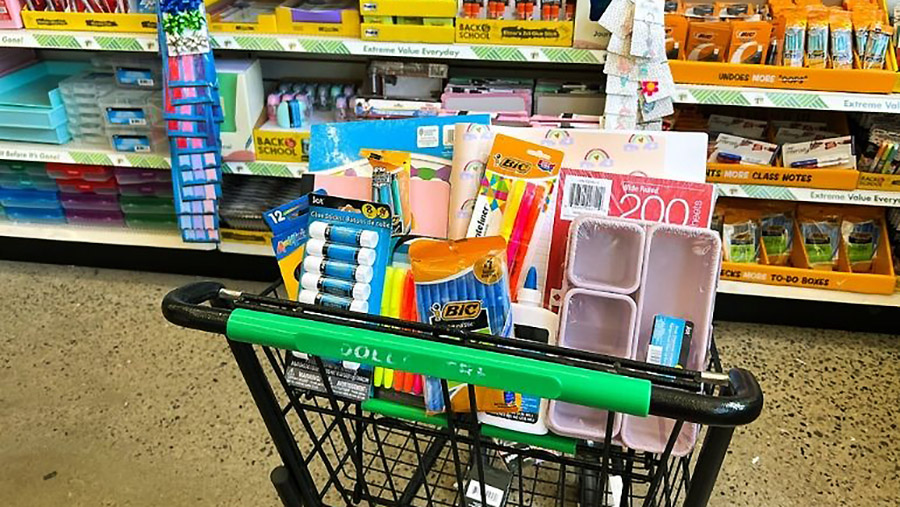Coresight Research’s U.S. back-to-school (BTS) 2023 study found the big BTS winner to be Walmart, with Amazon and Target losing ground. Dollar stores and off-pricers have also gained BTS share with those channels, as has Walmart, benefiting from the post-pandemic recovery in-store shopping.
The study forecasts that the average spend per child in 2023 will climb 9.2 percent as double-digit gains in in-store sales offset flat growth online. Among the findings:
- Compared to 2022, consumers who shop in-store expect to spend $279 per child on average, up $48, or 20.8 percent;
- Generally, consumers who plan to shop in-store (i.e., they may or may not also shop online) expect to spend 14.5 percent more than in 2022, to $292 per child.
- Online-only shoppers expect to spend the most in 2023, with an average spend per child of $339, the same level as in 2022.
The findings come from a June 2023 survey of 500 parents with kids ages 5-to-17, with the results compared to a similar study in 2022.
The survey found after the pandemic ushered in a new era of online-first shopping for many consumers, in-store shopping had remained relevant in BTS and rebounded slightly in 2023, with 78.0 percent of parents planning to shop in-store, up from 73.9 percent in 2022. Parents planning to shop online for BTS in 2023 and have products delivered to their door declined to 55.2 percent from 59.6 percent a year ago. Overall, 70.0 percent of parents expect to buy online this year, 48.4 percent expect to buy from two or more channels and the average respondent expects to use 1.7 channels.
Coresight wrote in its report, “Over the past two years of BTS shopping, year-over-year changes in behavior have been influenced largely by somewhat anomalous shifts in the retail landscape. In 2020 and 2021, BTS shopping came in the context of a once-in-a-generation pandemic, while 2022’s BTS season was the first to see inventories rebound and schooling fully back to business as usual—in the context of an unusually inflationary environment. This year, there is less to clearly distinguish the BTS context from last year’s, making any changes that do occur likely the result of changes in consumer preferences and more subtle differences in the broader retail context.
“With that in mind, consumers appear to continue to favor in-store BTS shopping, despite the prevalence of online shopping and availability of all BTS products through online channels. Those consumers who do spend online exclusively tend to skew in the higher-income bracket and plan to spend more, but our survey suggests that this year, it is in-store shopping that is set to see the largest growth. This means that Walmart, rather than Amazon, looks set to be the big winner of this BTS season.”
The study found that 60.2 percent of parents plan to shop BTS at Walmart this year, slightly down from 62.6 percent in 2022.
Much steeper declines in BTS spending were seen for Amazon and Target. Among the parents surveyed, 48.8 percent plan to BTS shop at Amazon this year, down from 60.3 percent in 2022. Only 39.0 percent plan to BTS shop at Target, down from 52.8 percent in 2022.
Coresight said that many retailers in the survey saw parents planning to shop with them less this BTS season, although low-price-point retailers, such as dollar-store chains, performed better, seeing modest increases in shopper numbers.
Those expected to see their BTS spending increase included Dollar Tree/Family Dollar, with 23.0 percent expecting to shop with the two sister chains in 2023 against 21.5 percent in 2022; TJX, 22.8 percent against 20.0 percent; Dollar General, 19.2 percent against 17.0 percent; Five Below, 16.0 percent versus 12.0 percent; Ross Stores, 15.6 percent against 12.9 percent; and Shein 10.2 percent compared with 6.6 percent.
Major chains expecting to see less traffic include Old Navy, with 21.6 percent of respondents expecting the shop the Gap-owned chain in 2023, down from 22.5 percent; Staples, 10.6 percent compared with 17.7 percent; Kohl’s, 9.8 percent against 20.6 percent, Macy’s, 9.6 percent versus 13.4 percent; Sam’s Club, 9.4 percent versus 18.6 percent; H&M, 7.8 percent against 8.6 percent; Costco, 7.4 percent versus 22.0 percent; Gap, 6.4 percent versus 9.1 percent, The Children’s Place, 6.2 versus 10.2 percent; and Best Buy, 6.2 percent against 14.7 percent.
The survey also explored other specialty stores not included in past surveys, including Foot Locker, leading the way with 13 percent of respondents planning to BTS shop at the sneaker chain in 2023, followed by Dick’s Sporting Goods, 12.0 percent; Shoe Carnival; 11.2 percent; Famous Footwear, 11 percent; Burlington Coat Factory, 10.2 percent; Temu, 9.2 percent; and American Eagle Outfitters, 8.4 percent.
Other findings from Coresight Research’s U.S. back-to-school survey include:
- Looking at consumers with household incomes of at least six figures, Target recorded almost as many shoppers as Walmart but less than half as many as Walmart in the sub-$50,000 group;
- Macy’s grabbed a share of 15.3 percent of consumers with six-figure household incomes, with Kohl’s at 13.5 percent;
- Dollar Tree/Family Dollar and Dollar General saw nearly four times as many low-income as high-income consumers;
- Temu, a newcomer to the U.S. retail scene, saw strength in the lowest-income group, with 17.5 percent of those with incomes under $50,000 planning to shop BTS with the retailer.
Photo courtesy Dollar General
















